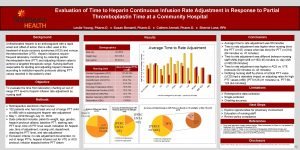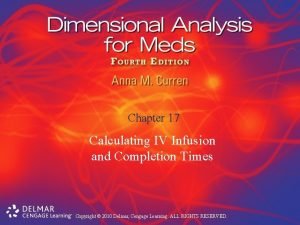Evaluation of Time to Heparin Continuous Infusion Rate

- Slides: 1

Evaluation of Time to Heparin Continuous Infusion Rate Adjustment in Response to Partial Thromboplastin Time at a Community Hospital Leslie Young, Pharm. D. ● Susan Boswell, Pharm. D. ● Colleen Arendt, Pharm. D. ● Sherrie Lane, RPh Background Methods 65. 6± 12. 4 Out of range PTTs n=257 Ø Retrospective electronic chart review Protocol Utilized per Patient Ø 102 patients who had at least one out of range PTT (≤ 44 VTE n=102 or ≥ 69) with a subsequent heparin rate adjustment [PERCE NTAGE] Ø May 1, 2019 through July 31, 2019 Ø Data collected includes: patient’s weight, age, gender, heparin protocol utilized, baseline PTT, starting rate, ACS PTT level, time of PTT level result, indication for heparin [PERCE use, time of adjustment, nursing unit, department NTAGE] drawing the PTT level, and rate adjustment Ø Exclusion criteria: no rate adjustment documented, no out of range PTTs, heparin infusion not for VTE or ACS protocol, infusion stopped before PTT drawn BS TE Limitations N ED O LE O R 2 (0. 8%) EU Observation (OBS) VP 2 (0. 8%) C Medical Telemetry (MED TELE) C 13 (5. 1%) N Neuroscience (NEURO) O 13 (5. 1%) G Cardiovascular Pavilion (CVP) R 16 (6. 2%) SU Oncology Progressive (ONC) 0 TU 21 (8. 2%) C Surgical (SURG) 10 U 25 (9. 7%) 20 IC Cardiothoracic Unit (CTU) 30 PC 28 (10. 9%) 40 S Intensive Care Unit (ICU) 50 R 137 (53. 3%) 60 O Cardiac Progressive (CPC) 70 O Nursing Unit 80 C M Age (years) t. IME TO r. ATE ADJUSTMENT (minutes) 93. 6 ± 28. 4 Weight (kg) FL To evaluate the time from laboratory charting an out of range PTT level to heparin infusion rate adjustment by nursing staff. 90 L Objective 62 (60. 8) Male (%) Ø Average time to rate adjustment was 50 minutes Ø Time to rate adjustment was higher when nursing drew the PTT (n=47) verses when lab drew the PTT (n=210) (64 minutes vs. 47 minutes) Ø Time to rate adjustment was different between nursing staff shifts [night shift (n=162) 45 minutes vs. day shift (n=95) 58 minutes] Ø Time to rate adjustment was higher in ACS vs. VTE protocols (52 minutes vs. 42 minutes) Ø Notifying nursing staff by phone of critical PTT value (≥ 125) had a desirable impact on adjusting rates for high PTT values (≥ 69) [PTT≥ 125 (31 minutes) vs. PTT 69124 (44 minutes)] Average Time to Rate Adjustment Demographics AL Unfractionated heparin is an anticoagulant with a rapid onset and offset of action that is often used in the treatment of acute coronary syndromes (ACS) and venous thromboembolism (VTE). Heparin infusions require frequent laboratory monitoring by collecting partial thromboplastin time (PTT) and adjusting infusion rates to achieve a targeted therapeutic range. Nursing staff are responsible for starting and adjusting heparin infusions according to institution-specific protocols utilizing PTT values reported in the patient’s chart. Conclusions Results All PTTs High PTTs (PTT≥ 69) Low PTTs (PTT≤ 44) Ø Retrospective data collection Ø Single-centered Ø Charting accuracy Next Steps Accuracy of Initial Dosing in VTE Protocol, Based on 18 unit/kg/hr n=23 [PERC ENTA GE] Initial rate inappropriate Initial rate appropriate Accuracy of Initial Dosing in ACS Protocol, Based on 12 unit/kg/hr or Max 10 m. L/hr n=79 [PERC ENTA GE] ≤ 83. 7 kg 19% [PERCE NTAGE] 34% Initial rate inappropriate Initial rate appropriate >83. 7 kg 81% Ø Explore opportunities for pharmacy involvement Ø Education of nursing staff Ø Review policy compliance 1. References Ø Drug Label Information: heparin sodium injection. Pfizer Laboratories Div Pfizer Inc. Last updated: 26 September 2019. Accessed 29 November 2019. Ø Garcia DA, Baglin TP, Weitz JI, et al. Parenteral Anticoagulants-Antithrombotic therapy and prevention of thrombosis, 9 th ed: American College of Chest Physicians evidence-based clinical practice guidelines. CHEST. 2012; 141(2 SUPPL. ): e 24 s-43 s. Disclosure Authors have nothing to disclose concerning possible financial or personal relationships with commercial entities.

